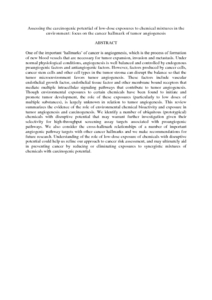Citation
Hu, Zhiwei and Brooks, Samira A. and Dormoy, Valérian and Hsu, Chia Wen and Hsu, Hsue Yin and Lin, Liang Tzung and Massfelder, Thierry and Rathmell, W. Kimryn and Xia, Menghang and Al-Mulla, Fahd and Al-Temaimi, Rabeah and Amedei, Amedeo and Brown, Dustin G. and Prudhomme, Kalan R. and Colacci, Anna Maria and Abd Hamid @ Abdul Razak, Roslida and Mondello, Chiara and Raju, Jayadev and Ryan, Elizabeth P. and Woodrick, Jordan and Scovassi, A. Ivana and Singh, Neetu and Vaccari, Monica and Roy, Rabindra and Forte, Stefano and Memeo, Lorenzo and Salem, Hosni K. and Lowe, Leroy and Jensen, Lasse and Bisson, William H. and Kleinstreuer, Nicole
(2015)
Assessing the carcinogenic potential of low-dose exposures to chemical mixtures in the environment: focus on the cancer hallmark of tumor angiogenesis.
Carcinogenesis, 36 (suppl.1).
S184-S202.
ISSN 0143-3334; ESSN: 1460-2180
Abstract
One of the important ‘hallmarks’ of cancer is angiogenesis, which is the process of formation of new blood vessels that are necessary for tumor expansion, invasion and metastasis. Under normal physiological conditions, angiogenesis is well balanced and controlled by endogenous proangiogenic factors and antiangiogenic factors. However, factors produced by cancer cells, cancer stem cells and other cell types in the tumor stroma can disrupt the balance so that the tumor microenvironment favors tumor angiogenesis. These factors include vascular endothelial growth factor, endothelial tissue factor and other membrane bound receptors that mediate multiple intracellular signaling pathways that contribute to tumor angiogenesis. Though environmental exposures to certain chemicals have been found to initiate and promote tumor development, the role of these exposures (particularly to low doses of multiple substances), is largely unknown in relation to tumor angiogenesis. This review summarizes the evidence of the role of environmental chemical bioactivity and exposure in tumor angiogenesis and carcinogenesis. We identify a number of ubiquitous (prototypical) chemicals with disruptive potential that may warrant further investigation given their selectivity for high-throughput screening assay targets associated with proangiogenic pathways. We also consider the cross-hallmark relationships of a number of important angiogenic pathway targets with other cancer hallmarks and we make recommendations for future research. Understanding of the role of low-dose exposure of chemicals with disruptive potential could help us refine our approach to cancer risk assessment, and may ultimately aid in preventing cancer by reducing or eliminating exposures to synergistic mixtures of chemicals with carcinogenic potential.
Download File
![[img]](http://psasir.upm.edu.my/43846/1.hassmallThumbnailVersion/Assessing%20the%20carcinogenic%20potential%20of%20low-dose%20exposures%20to%20chemical%20mixtures%20in%20the%20environment%20focus%20on%20the%20cancer%20hallmark%20of%20tumor%20angiogenesis.pdf)  Preview |
|
PDF (Abstract)
Assessing the carcinogenic potential of low-dose exposures to chemical mixtures in the environment focus on the cancer hallmark of tumor angiogenesis.pdf
Download (99kB)
| Preview
|
|
Additional Metadata
Actions (login required)
 |
View Item |

